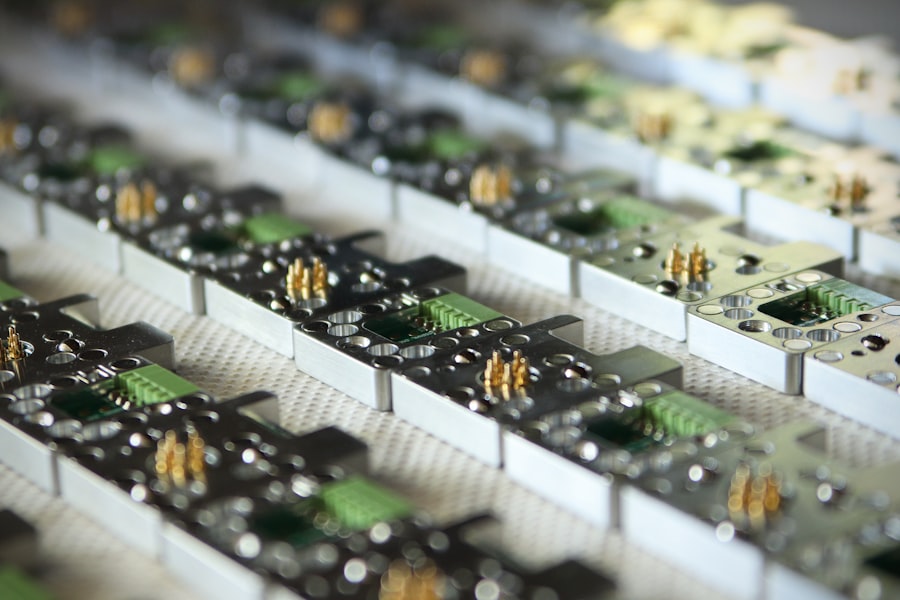Laser hair removal is a popular cosmetic procedure that uses a concentrated beam of light (laser) to remove unwanted hair. The laser targets the pigment in the hair follicles, heating them up and damaging the follicle to inhibit future hair growth. This procedure is effective for both men and women and can be used on various parts of the body, including the face, legs, arms, underarms, and bikini line.
Laser hair removal is a non-invasive procedure that offers long-term results. It is important to note that multiple sessions are usually required to achieve the best results, as hair grows in different cycles and the laser can only target hair in the active growth phase. It is also important to have realistic expectations about the results of laser hair removal. While it can significantly reduce hair growth, it may not result in permanent hair removal for everyone.
Key Takeaways
- Laser hair removal uses concentrated light to target and destroy hair follicles, leading to permanent hair reduction.
- Before your laser hair removal session, it’s important to avoid sun exposure and certain hair removal methods to ensure the best results.
- During the procedure, you may feel a slight discomfort or warmth as the laser targets the hair follicles, but it is generally well-tolerated.
- Aftercare involves protecting your skin from sun exposure and avoiding certain skincare products to promote healing and reduce the risk of complications.
- Potential side effects of laser hair removal include redness, swelling, and temporary pigment changes, but these are usually mild and resolve on their own.
Preparing for Your Laser Hair Removal Session
Before your laser hair removal session, it is important to follow some pre-treatment guidelines to ensure the best results and minimize the risk of complications. One of the most important things to do is to avoid sun exposure and tanning beds for at least six weeks before your treatment. Sun exposure can make the skin more sensitive to the laser and increase the risk of complications such as burns or discoloration.
It is also important to avoid plucking, waxing, or electrolysis for at least six weeks before your treatment. These hair removal methods can disturb the hair follicle and make laser hair removal less effective. Shaving is the only recommended method of hair removal before a laser session, as it preserves the hair shaft and follicle for the laser to target. Additionally, it is important to avoid using any skincare products that may irritate the skin, such as retinoids or exfoliating scrubs, in the days leading up to your treatment.
What to Expect During the Procedure
During your laser hair removal session, you can expect to wear protective eyewear to shield your eyes from the laser light. The technician will also apply a cooling gel to the treatment area to help protect the skin and facilitate the passage of the laser light. The technician will then use a handheld device to deliver the laser pulses to the treatment area. You may feel a slight stinging or snapping sensation as the laser targets the hair follicles, but most people find the discomfort to be tolerable.
The duration of the treatment will depend on the size of the treatment area, with smaller areas such as the upper lip taking just a few minutes, while larger areas like the legs may take up to an hour. After the treatment, you may notice some redness and swelling in the treated area, but this typically subsides within a few hours. It is important to follow any post-treatment instructions provided by your technician to ensure proper healing and optimal results.
Aftercare and Recovery
| Category | Metrics |
|---|---|
| Recovery Time | Days or weeks |
| Aftercare Plan | Follow-up appointments, therapy sessions |
| Medication Adherence | Percentage of prescribed medication taken |
| Physical Activity | Hours of exercise per week |
After your laser hair removal session, it is important to take good care of your skin to promote healing and minimize any potential side effects. It is normal to experience some redness and swelling in the treated area, which can be relieved with cold compresses or aloe vera gel. It is important to avoid sun exposure and tanning beds for at least a week after your treatment, as your skin may be more sensitive to UV rays.
It is also important to avoid hot showers, saunas, and strenuous exercise for at least 24 hours after your treatment to allow your skin to recover. Additionally, it is important to keep the treated area clean and moisturized to promote healing and prevent any complications such as infection or scarring. Your technician may also recommend using a gentle exfoliating scrub a few days after your treatment to help shed any treated hairs.
Potential Side Effects and Risks
While laser hair removal is generally considered safe, there are some potential side effects and risks to be aware of. These can include temporary discomfort such as redness, swelling, and a sunburn-like sensation in the treated area. In rare cases, more serious side effects such as blistering, scarring, or changes in skin pigmentation can occur. It is important to follow all pre- and post-treatment instructions provided by your technician to minimize the risk of complications.
It is also important to choose a reputable provider with trained and experienced technicians to ensure the safest and most effective treatment. It is important to disclose any medical conditions or medications you are taking before your treatment, as certain factors such as a history of keloid scarring or photosensitivity may increase your risk of complications.
Tips for Long-Term Maintenance

After completing your initial series of laser hair removal sessions, you may need occasional maintenance treatments to keep unwanted hair at bay. The frequency of maintenance treatments will vary depending on factors such as your hair type and skin color, as well as hormonal changes that can affect hair growth. It is important to follow any recommendations provided by your technician for long-term maintenance.
In addition to maintenance treatments, it is important to protect your skin from sun exposure and use sunscreen regularly to prevent any potential changes in skin pigmentation. It is also important to avoid plucking or waxing between treatments, as these methods can disrupt the hair follicle and make laser hair removal less effective. Shaving is the only recommended method of hair removal between treatments, as it preserves the hair shaft and follicle for the laser to target.
Choosing the Right Provider for Laser Hair Removal
When considering laser hair removal, it is important to choose a reputable provider with trained and experienced technicians who use FDA-approved equipment. It is important to research potential providers and read reviews from previous clients to ensure you are choosing a provider with a good track record of safety and effectiveness. It is also important to schedule a consultation with any potential provider to discuss your goals and expectations for treatment.
During your consultation, it is important to ask about the technician’s training and experience with laser hair removal, as well as any potential risks or complications associated with the treatment. It is also important to ask about the type of laser equipment used and how it specifically targets hair follicles while protecting surrounding skin. By choosing a reputable provider with trained technicians and FDA-approved equipment, you can feel confident in the safety and effectiveness of your laser hair removal treatment.
If you’re considering laser hair removal, you may also be interested in learning about the benefits of electrolysis hair removal. In a recent article on InLaserHairRemoval.com, they discuss the process and what to expect during the six weeks of regrowth for electrolysis hair removal. This informative piece provides valuable insights for those exploring different hair removal options. Check out the article here.
FAQs
What is laser hair removal?
Laser hair removal is a cosmetic procedure that uses a concentrated beam of light (laser) to remove unwanted hair. The laser targets the pigment in the hair follicles, damaging them and inhibiting future hair growth.
How does laser hair removal work?
During the procedure, the laser emits a light that is absorbed by the pigment in the hair follicles. This damages the follicles and inhibits future hair growth. Multiple sessions are usually required to achieve long-term hair reduction.
What areas of the body can be treated with laser hair removal?
Laser hair removal can be used to treat unwanted hair on various areas of the body, including the face, legs, arms, underarms, bikini line, and back.
Is laser hair removal permanent?
Laser hair removal can lead to long-term hair reduction, but it is not always permanent. Some hair may eventually grow back, but it is typically finer and lighter in color.
What should I expect during a laser hair removal session?
During a laser hair removal session, you can expect to wear protective eyewear to shield your eyes from the laser. The technician will use a handheld device to deliver the laser to the treatment area, and you may feel a slight stinging or snapping sensation as the laser targets the hair follicles.
How many laser hair removal sessions will I need?
The number of sessions needed for laser hair removal varies depending on factors such as the color and thickness of the hair, the area being treated, and individual skin type. Most people require multiple sessions, typically spaced several weeks apart, to achieve the best results.
What are the potential side effects of laser hair removal?
Common side effects of laser hair removal may include temporary redness, swelling, and discomfort in the treated area. In rare cases, blistering, scarring, or changes in skin pigmentation may occur. It’s important to discuss potential risks with a qualified provider before undergoing treatment.





